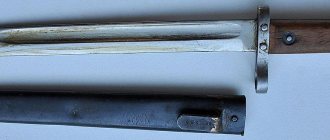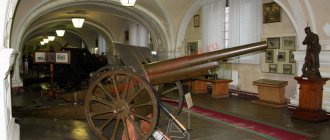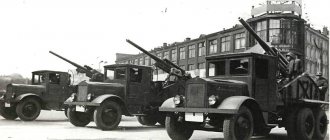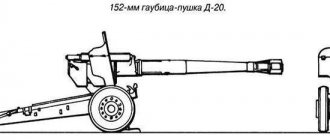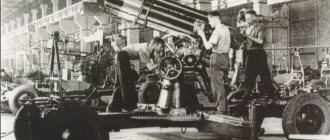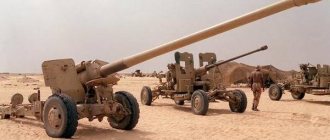76.2 mm mountain gun mod. 1904 (Russia)
76.2 mm mountain gun mod. 1904
Since February 1904, the Main Artillery Directorate has been testing a new 3-inch mountain gun, designed to replace the outdated 2.5-inch gun of the 1883 model. The new gun was developed in 1902 by the Obukhov Steel Plant in two versions—on a Perepelkin carriage and on Miller's carriage. In this regard, the plant was instructed to produce four guns of each variant, which were sent to mountain batteries stationed in the Caucasus. However, the tests that took place there were of a formal nature - back in January 1904. By the highest order, a 3-inch mountain gun on a Perepelkin carriage was chosen for mass production.
The war with Japan, which began in February 1904, forced the Main Artillery Directorate to order a batch of 48 new mountain guns from the Obukhov plant, and in total during 1904 contracts were signed for the supply of 294 guns to arm 26 foot mountain batteries and batteries of two cavalry mountain divisions . By the spring of 1905, 15 foot and 2 horse mountain batteries armed with cannons from the Obukhov plant were sent to the Far East. It is noteworthy that the gun was accepted for supply “retroactively” - on November 7, 1906 under the name “3-inch mountain rapid-fire gun mod. 1904."
Fans of two samples weighing 6.59 and 6.41 kg were produced for the gun; the explosive charge (melinite) was 0.368 and 0.785 kg, respectively. The initial speed of the grenade reached 289 m/s; it could hit a target at a distance of up to 4267 m.
Two samples of shrapnel shells were also produced, designed to destroy enemy personnel.
Russian artilleryman in rows with a 76.2 mm mountain gun mod. 1904. Externally, the size of the gun is quite impressive, but its weight, less than half a ton, was quite acceptable for its time. For example, a Russian field gun mod. 1902 of the same caliber was twice as heavy
The gun's rate of fire (with aiming correction) was 6 rounds per minute. To increase the stability of the gun when firing, the carriage had permanent and folding coulters.
Initially, the gun was deprived of a shield cover, but in 1911 a shield measuring 1600 x 1143 mm, consisting of 4 parts, was developed for it.
During the First World War, the mountain batteries of the Russian Army operating on the Caucasus Front were armed with these cannons. The swinging parts of the guns were placed in the turrets of armored trains and armored cars. Based on the gun mod. In 1904, an anti-assault gun was also developed, intended for arming fortresses.
Ammunition and ballistics
The 76-mm cannon of the 1938 model used its own shots, which were not interchangeable with other guns. The shots were completed in unitary cartridges, and some cartridges had a removable bottom, which made it possible to remove excess gunpowder bundles and shoot with reduced charges. The sleeve is brass, weighing 1.4 kg.
The Zh-356 variable charge was used for firing high-explosive fragmentation, incendiary and smoke projectiles, and was supplied in cartridge cases with a removable bottom. It consisted of a composite package attached to the bottom of the sleeve with varnish, and two removable bundles - the top and middle. The composite package included an igniter made of black gunpowder, a bunch of 4/1 gunpowder weighing 120 g and a bunch of 7/7 gunpowder weighing 80 g. The middle bunch was equipped with 7/7 gunpowder weighing 135 g, the top bunch was the same gunpowder weighing 285 g. When firing with a full charge, the beams were not removed from the cartridge case, while the initial speed of the high-explosive fragmentation projectile was 500 m/s, when firing with the first charge the upper beam was removed, the initial speed was 330 m/s, and when firing with the third charge the upper and middle beams were removed, the initial speed was 260 m/s. For these types of projectiles, a constant charge Zh-356V was also used, consisting of 642 g of 7/7 grade gunpowder poured into a cartridge case. To fire armor-piercing shells and shrapnel, a constant Zh-356B charge of 650 g of 7/7 grade gunpowder was used. The cumulative projectile was fired using a special Zh-356BPM charge weighing 125 g from WM 017/32 or 017/16 gunpowder.
The gun used the standard 76-mm shells of divisional guns, but their range of ammunition compared to the ammunition of regimental and divisional guns was smaller - the shots of mountain guns were not equipped with sub-caliber shells, old high-explosive grenades, buckshot, as well as some types of shrapnel and incendiary shells. Firing with BP-353A cumulative shells and shells with KTM-1 and KTM-2 fuses manufactured before 1938 was also prohibited.
The most frequently used steel high-explosive fragmentation projectile was the OF-350 and its variant with a body made of steel cast iron, the OF-350A. During the war, O-350A fragmentation shells were also used. The OF-350 projectile, when the fuse was set to fragmentation action, upon explosion, created 600-800 lethal fragments (weighing over 1 g), creating a continuous destruction area measuring 8 × 5 m (90% of targets are affected) and an actual destruction area measuring 30 × 15 m ( 50% of targets are hit). When the fuse was set to a delayed action, a funnel was created with a depth of 30-50 cm and a diameter of 70-100 cm.
Shrapnel came in two varieties, differing mainly in the type of spacer tube used. The Sh-354 shrapnel contained 260 round bullets with a diameter of 12.7 mm and a weight of 10.7 g each. The size of the zone of actual destruction by shrapnel was 20 m along the front, and in depth, depending on the distance and height of the explosion, from 260 to 300 m. Incendiary shells were represented by one type - Z-350 with thermite segments laid in three rows of three segments . When the projectile exploded, the segments ignited and scattered within a radius of 8 m, developing a combustion temperature of up to 2500 °C. OX-350 chemical fragmentation shells were filled with TNT and toxic substances such as R-12 or R-15. Chemical fragmentation shells were not included in the firing tables; to be able to use them, the shape and weight of these projectiles were identical to OF-350 high-explosive fragmentation grenades.
There were three types of armor-piercing shells; in 1941-1942, BR-350A shells were used, later BR-350B and BR-350SP. Due to the relatively low initial speed, armor-piercing shells were effective only when firing at light and medium tanks, and the latter were hit primarily when fired at the side or stern. BP-350M cumulative projectiles, which had penetration up to 100 mm at all distances, appeared in ammunition since 1944.
76.2 mm mountain gun mod. 1909 (Russia)
76.2 mm mountain gun mod. 1909
After demonstrating her new mountain cannon to Grand Duke Sergei Mikhailovich, the Highest order followed to suspend the contract concluded with the Putilov plant for the production of 194 mountain cannons mod. 1904 and test the mountain cannon and a similar cannon presented by .
Tests took place in the second half of 1908, and according to their results, the gun was recognized as the best. On February 26, 1909, it was adopted by the Russian Army under the name “3-inch mountain gun mod. 1909."
The first contract for the production of 214 mountain guns mod. 1909 was concluded with the Putilov plant in April 1909. In 1910, the St. Petersburg gun plant was also involved in the production of guns. He received a contract for 55 guns, which was fully completed by September 1914. This made it possible to supply the Russian Army with 440 guns of this type by August 1, 1914.
Even before the outbreak of the First World War, a second contract was signed with the Putilov plant for 772 mountain guns, of which 636 units were manufactured before the revolution. The St. Petersburg plant produced 349 guns between 1914 and 1917
Thus, the total number of guns manufactured before the revolution was 1,425 units, of which more than two-thirds were destroyed during the First World War and the Civil War.
Russian 76.2 mm guns in parade formation
An important advantage of the 76.2 mm gun mod. 1909 was that it fired the same unitary loading rounds as the most popular artillery system of the Russian Army - the 3-inch field gun of the 1902 model. This not only simplified the supply of mountain artillery battalions with ammunition, but also ensured high fire power .
Although the gun arr. 1909 was classified as mountain and was made collapsible; it was of little use for transporting it in packs, as is customary in mountain artillery.
Only the cartridge packs had a mass acceptable for a Russian-type pack horse - about 100 kg. The remaining packs were too heavy for the horses, as their weight varied from 120 to 240 kg.
For this reason, during the fighting, the mountain cannon mod. 1909, as a rule, was transported on wheels, and dragged over steep mountain passes by hand.
Based on the design of a 3-inch mountain gun mod. In 1909, a new Russian weapon was created. Since regimental artillery in the Russian army was abolished in 1800, the new cannon, which was in principle a regimental gun, was given the impersonal name “3-inch short gun arr. 1913." The main parts and mechanisms of the short cannon were unified with the mountain cannon mod. 1909, however, its barrel and carriage were non-separable. It was a light and maneuverable weapon, designed for direct fire support of infantry units and capable of accompanying infantry, as they say, “with fire and wheels.” The appearance of such a weapon was intended to reduce infantry losses during an offensive from machine-gun fire, which were not completely suppressed during artillery preparation. In total, 119 guns were manufactured at the Putilov plant in 1916, and in 1917 the Russian Army received another 54 guns. These guns came into service with separate field batteries, each of which was supposed to have 8 guns.
Changes made to the design during mass production
The first series guns had wooden wheels; the speed of towing a gun on good roads did not exceed 15 kilometers per hour. Since the ancestor of the 76-mm regimental gun of 1927 was the mountain gun of 1909, it inherited a collapsible barrel from it. The production technology for such barrels is quite complex and, as a result, expensive. But since there was no need for a detachable barrel for a regimental gun, and they didn’t want to change the production technology, they began to connect the casing and pipe in a hot state, which led to the fact that the barrel became impossible to disassemble. The technology for producing cheaper barrels - monoblocks - was mastered only in 1930.
Technical data of the 76-mm regimental gun mod. 1927
| Caliber, mm | 76,2 |
| Projectile weight, kg | 6,23-6,3 |
| Initial projectile speed, m/s | 387-370 |
| Vertical guidance angle | +25 -6° |
| Horizontal firing angle | 6° |
| Weight in firing position, kg | 900 |
| Weight in stowed position, kg | 1620 |
| Rate of fire, rds/min | 10-12 |
| Maximum firing range, m | 8500 |
| Direct shot range, m | 440 |
Ammunition and armor penetration.
Nomenclature of ammunition and armor penetration table.
(76-mm regimental gun model 1927. Firing tables. M, GAU. 1943)
The design of the gun was considered insufficiently modern. And in 1938, an order was issued to design a regimental gun with sliding frames and an elevation angle increased to 65 degrees. Moreover, the weight of the gun should not exceed 800 kg.
In pre-war times, the production of 76-mm regimental guns of 1927 was concentrated at the Putilov plant. In 1942, plant number 172 took over the production baton. With the development of production of the 76-mm regimental gun of 1943, the production of 76-mm regimental guns of 1927 was discontinued.
| Release of 76-mm regimental guns mod. 1927 to 1938-43 | ||||||
| Type of gun | 1938 | 1939 | 1940 | 1941 | 1942 | 1943 |
| 76-mm regimental gun model 1927. | 1000 | 1300 | 900 | 3918 | 6809 | 2555 |
Surviving copies
A weapon in Kiev
Due to its specificity and relative obscurity, the weapon has survived in a small number of copies. It can be seen in the Central Museum of the Armed Forces and the Central Museum of the Great Patriotic War in Moscow, in the Museum of National Military History in the village of Padikovo, Moscow Region, in the Central Museum of the Armed Forces of Ukraine in Kyiv, as well as in the Finnish Artillery Museum in the city of Hämeenlinna. The 107-mm howitzer 7-6 No. 4 can be seen in the Museum of the Armed Forces of the Republic of Kazakhstan in Astana.
Users[edit]
- Russian empire
- German Empire - Several captured M1910 barrels were coupled to newly built Krupp carriages and used by the German Army.
- Soviet Union. On November 1, 1936, the Red Army had 622 M1909 guns in service, of which 572 were serviceable, 34 were training guns, and 1 was unusable. 80 guns took part in the Winter War, 8 were lost. As of June 22, 1941, the Red Army had 1,121 M1906 guns, of which 366 were in reserve. [3]
- Kingdom of Romania - Romania may have operated an unknown number of captured M1909s that were converted to fire 75mm ammunition. In 1912, the Romanians also bought 24 75 mm Schneider- Danglis guns,
which they
called Tunul de munte Schneider, caliber 75 mm, md. 1912
. [9] - Poland - Poland could operate an unknown number under the designation 76.2 mm Armata górska wz.
1909 . - Finland – Finland captured 49 M1910 and 76 M1913 guns during the Finnish Civil War and designated them 76 LK/10
and
76 LK/13
.
Finland later purchased another 45 guns. Finland converted 40 captured M1910 guns, mounting them on Finnish M1913 carriages and designating them 76 LK/
10/13. [7] - Nazi Germany - In 1941, the Germans captured an unknown number of M1909s, which they designated 7.62 cm GebK 293(r)
. [1]
Gallery[edit]
- Greek general and politician Panagiotis Danglis.
- 76 mm M1910 counter-assault gun at the Novodevichy Convent in Moscow, Russia.
- Model 1910. Note the lightweight carriage.
- M1904 Mountain Gun (left) and M1909 Mountain Gun (right) at the National War Museum in Bucharest, Romania.
- German troops bring their Krupp 7.62 cm Infanteriegeschütz L/16.5 into position.
- A 76 K / 10/13 in Finland.

